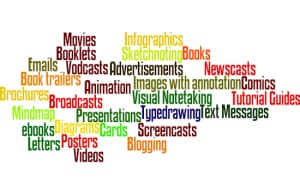All acts of communication are inevitably ‘multimodal’, in that all communication acts are a combination of modes. In written texts, the use of different fonts, styles, colours and other formatting tools are examples of multimodality. In speech, tone of voice, intonation, prosody and non-verbal cues constitute multimodality. But what about digital multimodality? Here we focus on how the use of digital texts, images, sounds, video, and animations can be used by students (and assessed by teachers) to communicate an argument.
Multimodality is the use of different media to create a single artefact.

Why should we encourage our students to use multimodality?
A review of the literature reveals three compelling reasons to develop multimodal skills:
- To keep up with a society that is increasingly digital and to ensure that assessment mirrors current and future employment needs outside of higher education and thus to prepare students for future employment. For some (very few?) careers, the medium of traditional academic writing may suit the needs of the job but, increasingly, we are required to present and persuade diverse audiences and this involves using a variety of media. So to prepare students for future jobs, we need to rethink and renew assessment practices. As some have put it:
When teaching practices are themselves using multimodality, it would seem odd to revert to traditional essay writing to assess a course.
- To be in tune with students’ expectations and literacy practices. Our students have grown up with access to screens and devices and will arguably be familiar with consumption of digital multimodal artefacts. However, we need to be cautious in our assumptions about students’ ability to be experts in all areas of technology, and we must not assume that they are able to engage critically with digital resources. The idea of the ‘Digital Native’ has been widely criticised and others have challenged the simplistic notion that students are all technologically competent. Introducing a multimodal assessment with support and scaffolding will give students the opportunity to explore and expand their digital literacy capabilities, as well as offer more choice in how they engage with assessments.
- To offer choice and flexibility in assessment. In recent years there have been calls for more flexibility and student ownership in assessment. There is strong evidence to suggest that students are more engaged when they can see future transferability and relevance in assessments.
With digital multimodal assessment, there is arguably the possibility of transferal of domain knowledge and an improvement in digital medium skills.
How can we encourage multimodality? Challenges and suggested support
There a several areas that we need to pay attention to regarding multimodal assessments:
How will it be graded? What are the criteria?
With multimodal assessment come questions of what should be assessed. What criteria do we use to assess the quality of the artefact? Do we assess the quality of the multimodality as well as the content and disciplinary understanding? It is important to help students understand what constitutes a good performance by providing them with clear goals, criteria and expected standards. This will, of course, also need to be considered in light of the unit and higher learning outcomes, as well as graduate qualities. In addition, it is important that students are active in the feedback process, and that students and teachers become responsible partners. There is obviously a great opportunity to incorporate these perspectives into assessment.
Suggestions
- Engage students in composing their own assessment criteria, which is discussed with peers and teachers
- Encourage students to submit drafts and comment on each other’s work and offer feedback throughout the process
- Consider using multimodality in feedback you provide to students in order to open a dialogue with them
Students’ and teachers’ technical skills
It’s important to not assume that students or teachers are experts at composing and creating digital multimodal artefacts. An Australian study of 2000 undergraduates found that although there was a wide range of digital exposure among students, we must not presume students possess the skills to, for example, use video or edit images. In addition, students may have a high degree of competence in navigating new technologies and be familiar with consumption of multimodal texts, but they may never have had to produce texts that are rhetorically sophisticated.
Suggestions
- Use a scaffolded and demonstrative approach, with examples of multimodality built into the unit content and teaching
- Take advantage of Lynda.com (free to all students and staff at the University) for tutorials on technology and software to upskill students
Understanding audience and genre
An understanding of audience is vital for students’ understanding of how to compose a multimodal assignment. In comparison to the more established genre of traditional academic writing, a multimodal assignment has a less well-defined audience. Students’ experiences of multimodality may lead them to assume that their audience is ‘everyone’, which can make it difficult for students to imagine their audience and pitch to the right context.
Suggestions
- Encourage discussion and reflection about the intended audience in class. Alternatively, make the intended audience explicit in the marking criteria.
- Set deadlines for deciding on audience to ensure students can progress with their assessment, and encourage peer review
Selecting suitable media for an argument
In comparison to the genre of academic essay writing, students may not have considered which media are best suited to a particular message or representation. Multimodal composition is arguably a more complex process than textual composition, as the focus is on not only what is being said, but how it is being said. Students need to draw upon “complex, hybrid, textual genres, using a range of technologies and applications“. Students may also feel a loss of control over their argument and need more support in preparing, drafting and editing.
Suggestions
- Introduce opportunities for ‘rhetorical viewing‘ (watching multimodal videos critically with the aid of questions)
- Use ‘semiotic mapping‘ to brainstorm the purpose of a text and which resources would suit their rhetorical purposes.
- Provide examples of different media.






1 Comment